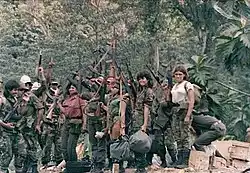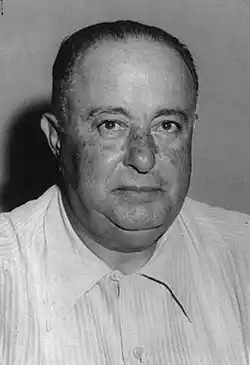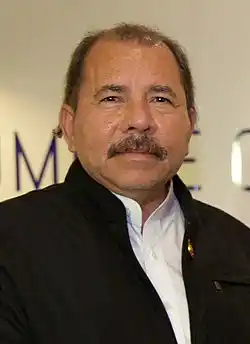
The Nicaraguan Revolution refers to a broad period in the history of Nicaragua in Central America between the 1960s and 1990 during which the influence of the Somoza family over the country’s politics and economy was challenged, leading eventually to the rise to power of the left-wing Sandinista government in 1979 and a civil war with the right-wing Contras through the 1980s. It only ended in 1990 when democratic elections led to the election of more politically moderate figures. The Revolution and the Contra War dragged Nicaragua into the Cold War as the Sandinista government allied with the Soviet Union and communist Cuba, while the Contras were backed by the United States. The conflict in the 1980s led to the deaths of tens of thousands of Nicaraguans in a country with a small population. It also triggered substantial outward migration, with hundreds of thousands of Nicaraguans leaving either for neighboring countries like Costa Rica or for the United States in the late 1970s, 1980s and 1990s.[1]
Research your ancestors on MyHeritage
Nicaraguan Revolution chronology of eventsNicaraguan Revolution chronology of events

The Nicaraguan Revolution was the result of nearly half a century of dominance of Nicaragua’s politics, economy and society by the Somoza family and their network of allies. In 1936 Anastasio Somoza Garcia, a US-educated army commander and politician, seized power in Nicaragua through a coup d’état, one which followed not long after a longstanding occupation of the country by the United States between 1912 and 1933. He then made himself president of the country from the 1st of January 1936. He would hold power for most of the period down to his death in September 1956 and after his demise several other members of the Somoza family either ruled Nicaragua as dictators or appointed allies to do so while remaining the real power behind the scenes. Even more wide-ranging was the extended Somoza family’s grip on the Nicaraguan economy. By the 1970s they owned over 20% of all land in Nicaragua and their accumulated wealth, businesses and other acquisitions constituted one-third of the Nicaraguan economy.[2]
The Nicaraguan Revolution was brewing from the early 1960s onwards as disillusionment concerning the power, influence and corruption of the Somoza family grew. In 1961 the Sandinista National Liberation Front (FSLN) was formed to oppose the Somoza family dictatorship. They derived their name from Augusto César Sandino, a Nicaraguan revolutionary who back in the late 1920s and early 1930s had opposed the US occupation of the country. The Sandinistas initiated an insurgency war against the government in the 1960s. It gained in strength, particularly so following a heavy-handed government crackdown on political dissidents in 1978. As a consequence, the Sandinistas were able to oust Anastasio Somoza Debayle from power in 1979 and formed a far-left, socialist government, one which allied with Fidel Castro’s Cuba and the Soviet Union.[3]

The rise to power of the Sandinistas elicited a response from the United States. They began channeling aid to the far-right Contra rebels who now opposed the newly constituted Sandinista Junta of National Reconstruction. The Contras were not a homogenous group, but rather a broad coalition of anti-Sandinista entities. With US military and financial support they waged a war throughout the 1980s against the Sandinista government.[4] The Contra War was a bitter struggle, one marked by high degrees of militarization across Nicaraguan society, displacement, terrorist attacks, atrocities and a refugee crisis.[5]
The conflict only came to an end in 1990 when national elections were held and Violeta Chamarro was surprisingly elected as president for the National Opposition Union, defeating Daniel Ortega, the Sandinista candidate. Chamarro proved to be a leader capable of compromise that stabilized the political situation in Nicaragua to a significant extent during her six-year term as president. Ortega would continue to stand as a presidential candidate in years to come and won the 2006 presidential election. He assumed office in January 2007 and has ruled the country as an increasingly undemocratic and illiberal president ever since.[6]
Extent of migration caused by the Nicaraguan RevolutionExtent of migration caused by the Nicaraguan Revolution
Nicaragua was a country with a small population of only around three million people by 1978 when the major unrest began. Nevertheless, the violence and instability that followed still set off a wave of migration which would see hundreds of thousands of Nicaraguans move from their home places to greener pastures in the late 1970s, 1980s and 1990s. Some were displaced internally within Nicaragua, others headed to neighboring countries like Costa Rica, and more still travelled further afield, particularly so to the United States. For instance, approximately 35,000 Nicaraguans were registered in Costa Rica in the 1980s owing to the conflict at home.[7] A wave of some 120,000 Nicaraguans migrated to the United States between 1979 and 1990 during the years of the Contra War.[8]
Demographic impact of the Nicaraguan RevolutionDemographic impact of the Nicaraguan Revolution
The demographic impact of the Nicaraguan Revolution and the migration attendant on it was felt most keenly in two countries: Costa Rica and the United States. In 2020 there were 368,000 Nicaraguans living in Costa Rica, constituting 7% of the country’s population of approximately five million people. A great proportion of these people arrived during the 1970s, 1980s and 1990s as a result of the violence in their homeland, or are second or third-generation descendants of those same refugees.[9]
There are roughly a quarter of a million people of Nicaraguan descent in the United States today, though some studies argue that there are upwards of 450,000 people in the US of Nicaraguan heritage, making them the thirteenth largest Hispanic group in the country.[10] By way of contrast, the Nicaraguan American community was almost non-existent prior to the 1960s and was built on the back of migration during and after the Nicaraguan Revolution. Beyond these, there are tens of thousands of people of Nicaraguan birth or heritage in Spain, Canada, Panama, Guatemala, Mexico and Honduras today, many of whom will be able to trace their family roots to people who left Nicaragua during the revolutionary period of the 1960s, 1970s and 1980s.
See alsoSee also
Explore more about the Nicaraguan RevolutionExplore more about the Nicaraguan Revolution
- The Nicaraguan Revolution at ThoughtCo
- Nicaragua, Civil Registration, 1809-2011 records collection on MyHeritage
- Costa Rica, Birth Index, 2011-2015 records collection on MyHeritage
References
- ↑ https://americanarchive.org/exhibits/newshour-cold-war/nicaragua
- ↑ https://www.britannica.com/topic/Somoza-family
- ↑ https://www.brown.edu/Research/Understanding_the_Iran_Contra_Affair/n-sandinistas.php
- ↑ https://www.thoughtco.com/nicaraguan-revolution-4777782
- ↑ Luis A. Moreno, The Contras War (California, 2016).
- ↑ https://time.com/6957847/nicaragua-history-politics/
- ↑ Elizabeth M. Larson, ‘Nicaraguan Refugees in Costa Rica from 1980–1993’, in Yearbook (Conference of Latin Americanist Geographers), Vol. 19 (1993), pp. 67–79.
- ↑ Lisa Konczal, ‘Nicaraguan Immigrants’, in Ron Baylor (ed.), Multicultural America: An Encyclopedia of the Newest Americans (Westport, Connecticut, 2011).
- ↑ https://www.migrationpolicy.org/article/costa-rica-nicaragua-migrants-subtle-barriers
- ↑ https://www.pewresearch.org/race-and-ethnicity/fact-sheet/us-hispanics-facts-on-nicaraguan-origin-latinos/

